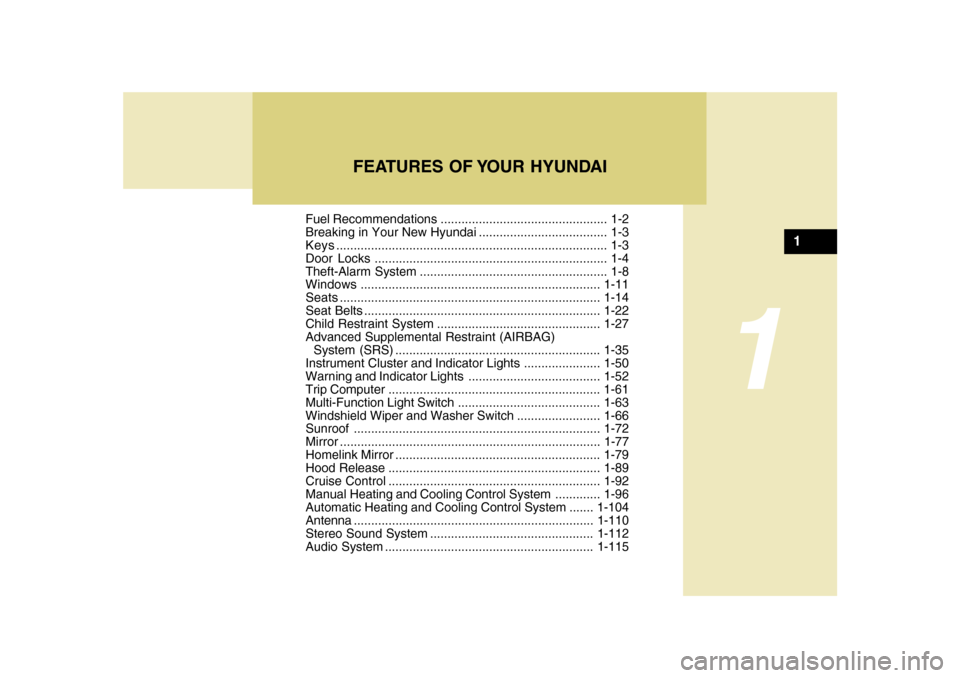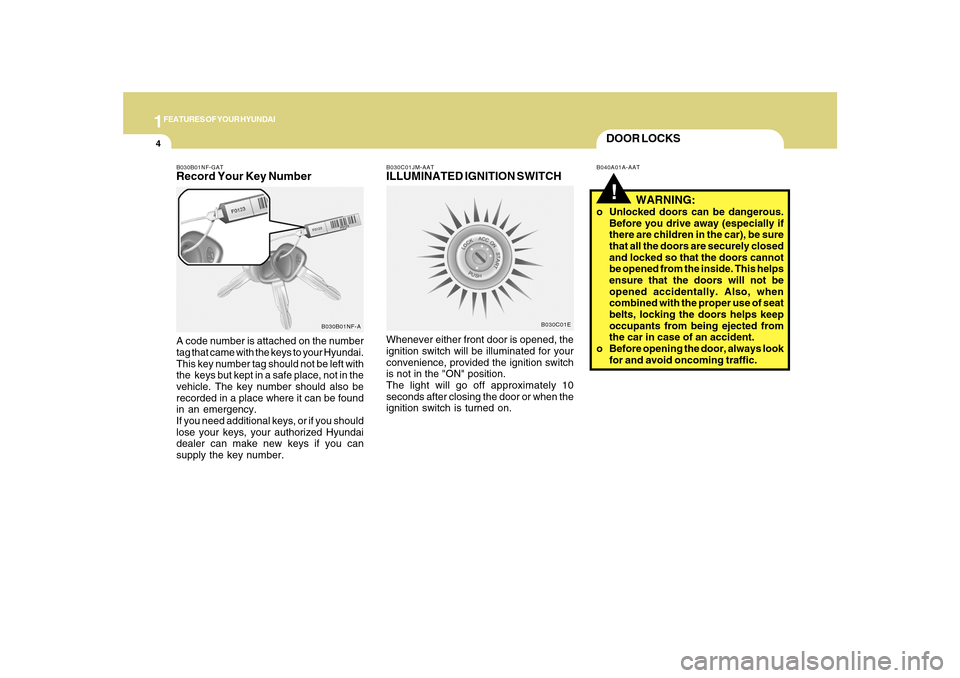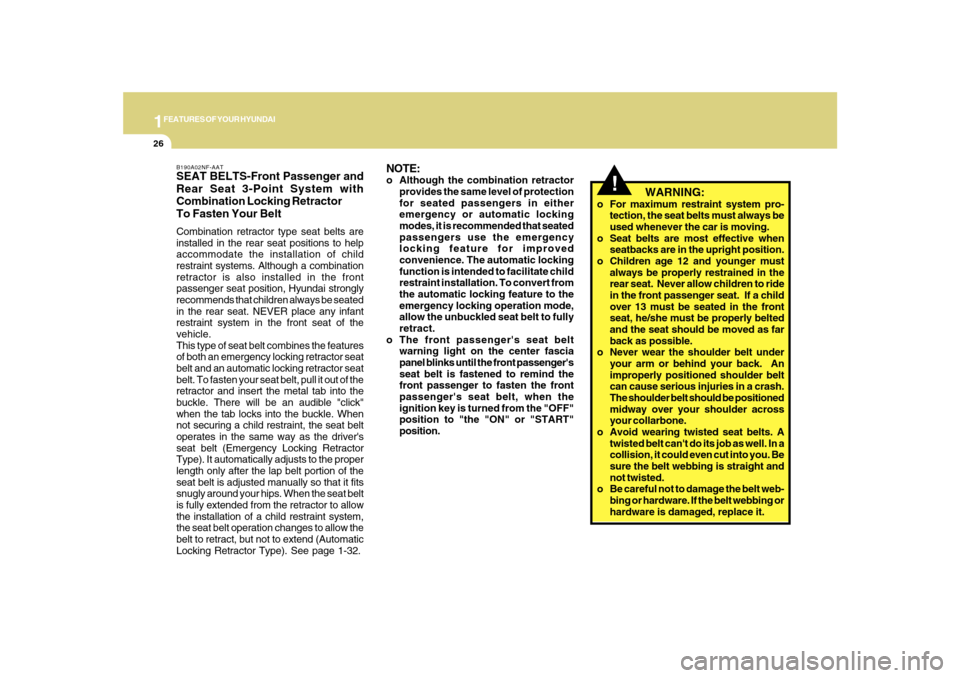2010 Hyundai Sonata warning light
[x] Cancel search: warning lightPage 11 of 285

F11
1. Driver’s air bag
2. Light control / Turn signals
3. Instrument cluster
4. Wiper/Washer
5. Cruise control switch*
6. Ignition switch
7. "PASSENGER AIR BAG OFF" Indicator
8. Digital clock*
9. Audio controls*
10. Heating/Air conditioning control panel*
CAUTION:
When installing a container of liquid air freshener inside the vehicle, do not place it near the instrument cluster
nor on the instrument panel surface. If there is any leakage from the air freshener onto these areas
(Instrument cluster, instrument panel or air ventilator), it may damage these parts. If the liquid from the air
freshener does leak onto these areas, wash them with water immediately.
!
11. Hazard warning flasher switch
12. Seat warmer*
13. Shift lever
14. Cigarette lighter
15. Power outlet
16. Ashtray
17. Passenger’s air bag
18. Vent controls
19. Glove box
* : if installed
Page 12 of 285

YOUR VEHICLE AT A GLANCE
F12
B255A02NF-AATINDICATOR SYMBOLS ON THE INSTRUMENT CLUSTER
High Beam Indicator Light
Door Ajar Warning LightSeat Belt Reminder Light and ChimeTurn Signal Indicator Lights
ABS Service Reminder Indicator (If Installed)
Low Oil Pressure Warning Light
Parking Brake/Low Brake Fluid Level
Warning Light
Charging System Warning Light
SRS (Airbag) Warning Light
Cruise Indicator Light Check Engine - Malfunction Indicator Light (MIL)
Electronic Stability Control (ESC) Indicator
Lights
Low Windshield Washer Fluid Level Warning LightFront Fog Light Indicator Light (If Installed)
Cruise SET Indicator LightLow Fuel Level Warning Light
Trunk Lid Open Warning Light
* More detailed explanations of these items will be found beginning on page 1-52.
Low Tire Pressure Telltale (If Installed)TPMS (Tire Pressure Monitoring System) Malfunction
Telltale (If Installed)
Page 14 of 285

1
Fuel Recommendations ................................................ 1-2
Breaking in Your New Hyundai ..................................... 1-3
Keys.............................................................................. 1-3
Door Locks ................................................................... 1-4
Theft-Alarm System ...................................................... 1-8
Windows..................................................................... 1-11
Seats........................................................................... 1-14
Seat Belts.................................................................... 1-22
Child Restraint System ............................................... 1-27
Advanced Supplemental Restraint (AIRBAG)
System (SRS) ........................................................... 1-35
Instrument Cluster and Indicator Lights ...................... 1-50
Warning and Indicator Lights ...................................... 1-52
Trip Computer ............................................................. 1-61
Multi-Function Light Switch ......................................... 1-63
Windshield Wiper and Washer Switch ........................ 1-66
Sunroof....................................................................... 1-72
Mirror ...........................................................................1-77
Homelink Mirror ........................................................... 1-79
Hood Release ............................................................. 1-89
Cruise Control ............................................................. 1-92
Manual Heating and Cooling Control System ............. 1-96
Automatic Heating and Cooling Control System....... 1-104
Antenna.....................................................................1-110
Stereo Sound System...............................................1-112
Audio System............................................................1-115
FEATURES OF YOUR HYUNDAI
1
Page 15 of 285

1FEATURES OF YOUR HYUNDAI2
!
B010A01NF-A
FUEL RECOMMENDATIONS
CAUTION:
Your Hyundai's New Vehicle Limited War-
ranty may not cover damage to the fuel
system and any performance problems
that are caused by the use of fuels con-
taining methanol or fuels containing
MTBE (Methyl Tertiary Butyl Ether) over
15.0% vol. (Oxygen Content 2.7% weight.)
B010B01A-AATWhat About Gasohol?Gasohol (a mixture of 90% unleaded
gasoline and 10% ethanol or grain alcohol)
may be used in your Hyundai. However, if
your engine develops driveability
problems, the use of 100% unleaded
gasoline is recommended. Fuels with
unspecified quantities of alcohol, or
alcohols other than ethanol, should not be
used.
B010A02NF-AATUse Unleaded GasolineUnleaded gasoline with a Pump Octane
Rating of 87 (Research Octane Number
91) or higher must be used in your
Hyundai.
B010C01A-AATUse of MTBEHyundai recommends that fuels
containing MTBE (Methyl Tertiary Butyl
Ether) over 15.0% vol. (Oxygen Content
2.7% weight) should not be used in your
Hyundai.
Fuel containing MTBE over 15.0% vol.
(Oxygen Content 2.7% weight) may reduce
vehicle performance and produce vapor
lock or hard starting.
B010D01A-AATDo Not Use MethanolFuels containing methanol (wood alcohol)
should not be used in your Hyundai. This
type of fuel can reduce vehicle
performance and damage components of
the fuel system.
!
UNLEADED
FUEL ONLY
WARNING:
o Do not "top off" after the nozzle auto-
matically shuts off when refueling.
o Tighten the cap until it clicks, otherwise
the "
" check engine light will
illuminate.
o Always check that the fuel cap is
installed securely to prevent fuel
spillage in the event of an accident.
Page 17 of 285

1FEATURES OF YOUR HYUNDAI4
DOOR LOCKS!
B040A01A-AAT B030C01JM-AAT
ILLUMINATED IGNITION SWITCHWhenever either front door is opened, the
ignition switch will be illuminated for your
convenience, provided the ignition switch
is not in the "ON" position.
The light will go off approximately 10
seconds after closing the door or when the
ignition switch is turned on.
WARNING:
o Unlocked doors can be dangerous.
Before you drive away (especially if
there are children in the car), be sure
that all the doors are securely closed
and locked so that the doors cannot
be opened from the inside. This helps
ensure that the doors will not be
opened accidentally. Also, when
combined with the proper use of seat
belts, locking the doors helps keep
occupants from being ejected from
the car in case of an accident.
o Before opening the door, always look
for and avoid oncoming traffic.
B030B01NF-GATRecord Your Key NumberA code number is attached on the number
tag that came with the keys to your Hyundai.
This key number tag should not be left with
the keys but kept in a safe place, not in the
vehicle. The key number should also be
recorded in a place where it can be found
in an emergency.
If you need additional keys, or if you should
lose your keys, your authorized Hyundai
dealer can make new keys if you can
supply the key number.
B030B01NF-A
B030C01E
Page 23 of 285

1FEATURES OF YOUR HYUNDAI10
HNF2005
Battery
2. Remove the old battery from the case
and note the polarity. Make sure the
polarity of the new battery is the
same(+side facing up), then insert it in
the transmitter.
B070E02NF-GATReplacing the batteryWhen the transmitter's battery begins to
get weak, it may take several pushes on
the button to lock or unlock the doors, and
the LED will not light. Replace the battery
as soon as possible.
Battery type : CR2032
Replacement instructions:
1. Carefully separate the case with a coin
as shown in the illustration.
ONF048120
B070E01NF-AATPanic Warning1. Push the "PANIC" button on the backside
of the transmitter.
2. At the same time, the alarm horn will
sound and the turn signal lights will
blink continuously for 30 seconds.
3. To turn off the system, push the "PANIC"
button again on the backside of the
transmitter.
7B070E02NF-A
!
CAUTION:
An inappropriately disposed battery can
be harmful to the environment and hu-
man health.
Dispose the battery according to your
local law(s) or regulation.
Page 38 of 285

1
FEATURES OF YOUR HYUNDAI
25
B180A02NF-AATSEAT BELT-Driver's 3-Point System
with Emergency Locking Retractor
To Fasten Your BeltTo fasten your seat belt, pull it out of the
retractor and insert the metal tab into the
buckle. There will be an audible "click"
when the tab locks into the buckle.
The seat belt automatically adjusts to the
proper length only after the lap belt portion
is adjusted manually so that it fits snugly
around your hips. If you lean forward in a
slow, easy motion, the belt will extend and
let you move around. If there is a sudden
stop or impact, however, the belt will lock
into position. It will also lock if you try to lean
forward too quickly.
B180A01NF
NOTE:o If you are not able to pull out the seat
belt from the retractor, firmly pull the
belt out and release it. Then you will be
able to pull the belt out smoothly.
o If the driver's seat belt is not fastened
when the ignition key is turned from
the "OFF" position to the "ON" or
"START" position, the seat belt warn-
ing light will blink and the warning
chime will sound for approximately
six seconds to remind the driver to
fasten the driver's seat belt.
!
Release the button to lock the anchor into
position. Try sliding the height adjuster to
make sure that it has locked into position.
WARNING:
o Verify the shoulder belt anchor is
locked into position at the appropriate
height. Never position the shoulder
belt across your neck or face.
Improperly positioned seat belts can
cause serious injuries in an accident.
o Failure to replace seat belts after an
accident could leave you with
damaged seat belts that will not
provide protection in the event of
another collision leading to personal
injury or death. Replace your seat
belts after being in an accident as
soon as possible.
!
WARNING:
o Adjust the shoulder belt height when
you sit well back in the seat.
o When adjusting the shoulder belt
height, grip the height adjuster button
securely and slide the height adjuster
up or down.
Page 39 of 285

1FEATURES OF YOUR HYUNDAI26
B190A02NF-AATSEAT BELTS-Front Passenger and
Rear Seat 3-Point System with
Combination Locking Retractor
To Fasten Your BeltCombination retractor type seat belts are
installed in the rear seat positions to help
accommodate the installation of child
restraint systems. Although a combination
retractor is also installed in the front
passenger seat position, Hyundai strongly
recommends that children always be seated
in the rear seat. NEVER place any infant
restraint system in the front seat of the
vehicle.
This type of seat belt combines the features
of both an emergency locking retractor seat
belt and an automatic locking retractor seat
belt. To fasten your seat belt, pull it out of the
retractor and insert the metal tab into the
buckle. There will be an audible "click"
when the tab locks into the buckle. When
not securing a child restraint, the seat belt
operates in the same way as the driver's
seat belt (Emergency Locking Retractor
Type). It automatically adjusts to the proper
length only after the lap belt portion of the
seat belt is adjusted manually so that it fits
snugly around your hips. When the seat belt
is fully extended from the retractor to allow
the installation of a child restraint system,
the seat belt operation changes to allow the
belt to retract, but not to extend (Automatic
Locking Retractor Type). See page 1-32.
NOTE:o Although the combination retractor
provides the same level of protection
for seated passengers in either
emergency or automatic locking
modes, it is recommended that seated
passengers use the emergency
locking feature for improved
convenience. The automatic locking
function is intended to facilitate child
restraint installation. To convert from
the automatic locking feature to the
emergency locking operation mode,
allow the unbuckled seat belt to fully
retract.
o The front passenger's seat belt
warning light on the center fascia
panel blinks until the front passenger's
seat belt is fastened to remind the
front passenger to fasten the front
passenger's seat belt, when the
ignition key is turned from the "OFF"
position to "the "ON" or "START"
position.
WARNING:
o For maximum restraint system pro-
tection, the seat belts must always be
used whenever the car is moving.
o Seat belts are most effective when
seatbacks are in the upright position.
o Children age 12 and younger must
always be properly restrained in the
rear seat. Never allow children to ride
in the front passenger seat. If a child
over 13 must be seated in the front
seat, he/she must be properly belted
and the seat should be moved as far
back as possible.
o Never wear the shoulder belt under
your arm or behind your back. An
improperly positioned shoulder belt
can cause serious injuries in a crash.
The shoulder belt should be positioned
midway over your shoulder across
your collarbone.
o Avoid wearing twisted seat belts. A
twisted belt can't do its job as well. In a
collision, it could even cut into you. Be
sure the belt webbing is straight and
not twisted.
o Be careful not to damage the belt web-
bing or hardware. If the belt webbing or
hardware is damaged, replace it.
!